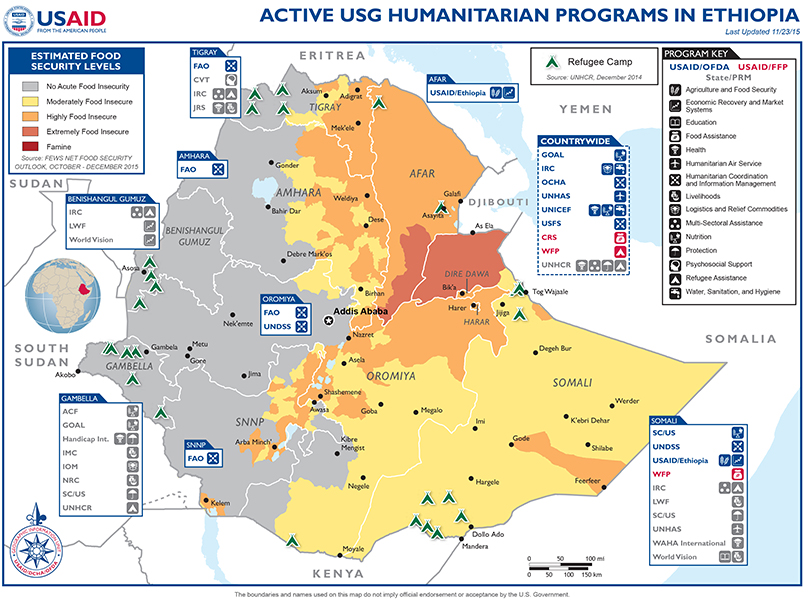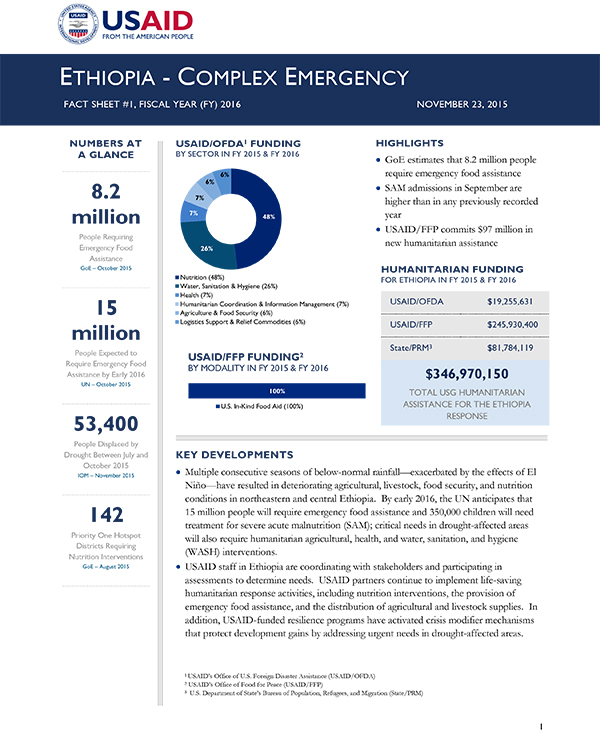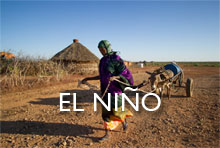- What We Do
- Agriculture and Food Security
- Democracy, Human Rights and Governance
- Economic Growth and Trade
- Education
- Ending Extreme Poverty
- Environment and Global Climate Change
- Gender Equality and Women's Empowerment
- Global Health
- Water and Sanitation
- Working in Crises and Conflict
- Disaster Assistance
- Political Transition Initiatives
- Conflict Mitigation and Prevention
- Countering Violent Extremism
- Disaster Risk Reduction
- Peacebuilding and Reconciliation
- Providing Safe & Secure Environments for Development
- Recovering From Crisis
- Resilience
- Tech Challenge for Atrocity Prevention
- World Humanitarian Day
- U.S. Global Development Lab
November 23, 2015
Highlights
GoE estimates that 8.2 million people require emergency food assistance
SAM admissions in September are higher than in any previously recorded year
USAID/FFP commits $97 million in new humanitarian assistance
Key Developments
Ethiopia Map - 11-23-2015 ![]() (pdf - 808k)
(pdf - 808k)
Numbers At A Glance
8.2 million
15 million
53,400
142
Humanitarian Funding
For the Ethiopia Response
FY 2015 - 2016
| USAID/OFDA | $19,255,631 |
| USAID/FFP | $245,930,400 |
| State/PRM | $81,784,119 |
| TOTAL | $346,970,150 |
Multiple consecutive seasons of below-normal rainfall—exacerbated by the effects of El Niño—have resulted in deteriorating agricultural, livestock, food security, and nutrition conditions in northeastern and central Ethiopia. By early 2016, the UN anticipates that 15 million people will require emergency food assistance and 350,000 children will need treatment for severe acute malnutrition (SAM); critical needs in drought-affected areas will also require humanitarian agricultural, health, and water, sanitation, and hygiene (WASH) interventions.
USAID staff in Ethiopia are coordinating with stakeholders and participating in assessments to determine needs. USAID partners continue to implement life-saving humanitarian response activities, including nutrition interventions, the provision of emergency food assistance, and the distribution of agricultural and livestock supplies. In addition, USAID-funded resilience programs have activated crisis modifier mechanisms that protect development gains by addressing urgent needs in drought-affected areas
AGRICULTURE AND FOOD SECURITY
During 2015, the population in Ethiopia requiring humanitarian assistance has continued to increase—from 2.9 million people in early 2015 to 4.5 million people in August, according to the Government of Ethiopia (GoE). By October, the population requiring emergency food assistance in Ethiopia had further increased to approximately 8.2 million people. Water and pasture shortages have decreased livestock production and caused livestock deaths in pastoralist and agropastoralist communities, further deteriorating the food security and nutrition situation in drought-affected regions. The UN has identified affected populations in parts of Afar, Amhara, Oromiya, Somali, Southern Nations, Nationalities, and Peoples (SNNP), and Tigray regions, and projects that up to 15 million people in Ethiopia will likely require emergency food assistance by early 2016.
The USAID-funded Famine Early Warning Systems Network (FEWS NET) reported that vulnerable households in southern Afar and in Somali Region’s Sitti Zone were at Emergency—IPC 4—levels of food insecurity in October and would likely remain at Emergency levels through March 2016.4 Populations in northern and central Afar, as well as parts of Amhara, Oromiya, SNNP, and Tigray, were at Crisis—IPC 3—levels of food security in October and anticipated to remain there through the coming months. Other parts of Amhara, Oromiya, SNNP, and Tigray were at Stressed—IPC 2—levels of food security in October, with FEWS NET predicting a deterioration to Crisis levels by March 2016.
The nation-wide meher seasonal assessment occurred one month earlier than previously planned, in order to inform needs and target populations for the 2016 Humanitarian Requirements Document (HRD), produced by the GoE in coordination with humanitarian stakeholders and planned for release in December. Between October 24 and November 6, staff from USAID/Ethiopia’s Office of Asset Livelihood and Transition (USAID/ALT)—together with GoE officials and donor and non-governmental organization (NGO) staff—participated in a meher assessment in Oromiya and SNNP. Based upon preliminary reports, it is expected that food assistance needs from January–September 2016 will significantly increase, most notably in Ethiopia’s highlands.
Drought-affected populations are relocating in an effort to improve access to food, water, and livelihood opportunities; the International Organization for Migration (IOM) reports that drought conditions contributed to the displacement of 53,400 people between July and October.
In response to the deteriorating food security situation, the GoE has committed more than $200 million to address emergency food and other humanitarian needs. In addition, the GoE had provided 6,800 metric tons (MT) of maize—of a total 50,000 MT planned for distribution—to populations in affected areas as of November 2, according to the UN. GoE distributions of 50,000 MT of wheat and 300 MT of oil were ongoing in early November.
In October, USAID/FFP provided approximately 105,700 MT of emergency food assistance—valued at approximately $58 million—to the Catholic Relief Services-led Joint Emergency Operation Program (CRS/JEOP). USAID/FFP anticipates making additional contributions as soon as funds become available.
USAID/FFP also contributed nearly 26,000 MT of emergency food commodities—valued at nearly $19 million—to the UN World Food Program (WFP) relief pipeline in Ethiopia. In addition, USAID/FFP recently provided approximately 22,700 MT of emergency food commodities—valued at $20 million—to WFP to address urgent food needs of refugees. As of October, USAID/FFP assistance was enabling WFP and other partners to reach 3.5 million people with emergency food assistance; USAID/FFP continues to assess response gaps and plan assistance accordingly.
Since 2005, USAID/FFP has also supported the GoE’s Productive Safety Net Program (PSNP)—the first line of response for any food security crisis in Ethiopia. In July 2015, the GoE increased the PSNP caseload to reach 7.9 million people. In addition to planned food distributions, the PSNP maintains a contingency budget that can respond to urgent acute needs. In response to the current conditions, the GoE has authorized the use of more than 50 percent of the 2016 PSNP contingency budget—normally used to cover expanded needs during the June-September 2016 lean season.
In addition to emergency response activities, the USAID-funded Graduation with Resilience to Achieve Sustainable Development (GRAD) program continues to implement livelihood promotion and diversification activities for 65,000 vulnerable households in Amhara, Oromiya, SNNP, and Tigray. GRAD maintains a crisis modifier—supported with USAID/OFDA funding—designed to protect development gains during shocks. GRAD has activated the crisis modifier in SNNP and to date has assisted an estimated 1,150 drought-affected households with emergency seed and livestock feed supplies.
A separate USAID resilience initiative, the Pastoralist Areas Resilience Improvement through Market Expansion (PRIME) program, has similarly activated a crisis modifier. With USAID/OFDA support, PRIME—through implementing partner Mercy Corps—has provided supplementary feed and fodder to more than 15,200 households in Afar’s Zone 3 and in Sitti, complementing commercial destocking and veterinary activities in affected areas.
NUTRITION
The GoE reported 142 priority one hotspot districts requiring urgent nutrition interventions as of August. The UN notes that a multi-agency team reviews hotspot districts quarterly; the release of the next hotspot classification is anticipated for early December and will likely result in an increased number of priority one hotspot districts.
The GoE reported that nutrition actors had treated more than 37,200 cases of severe acute malnutrition (SAM) in Ethiopia during September. While September SAM admissions represented a 14 percent reduction compared to the 43,400 cases treated in August, the UN notes a typical seasonal decline in SAM admissions from August to September; the September caseload is at least 20 percent higher than the number of SAM admissions recorded during September in any other documented year.
In FY 2015, USAID/OFDA provided $8.7 million to partners—including the UN Children’s Fund (UNICEF), GOAL, and Save the Children/U.S. (SC/US)—responding to malnutrition throughout Ethiopia. USAID/OFDA-supported nutrition interventions remain ongoing in FY 2016.
USAID/FFP has provided approximately 3,600 MT of corn soy blend plus (CSB+)—valued at $2.1 million—to support GOAL’s ongoing nutrition interventions in FY 2015 and to date in FY 2016.
HEALTH AND WASH
Health actors confirmed more than 14,500 measles cases, affecting more than 200 locations in Ethiopia, between January and September 2015. In October, the GoE Ministry of Health—in coordination with other health actors—began measles vaccinations in priority one and two hotspot districts, targeting 5.3 million children under five years of age.
Drought conditions are limiting access to water for vulnerable populations; in September, the UN reported that approximately 1.8 million people in Ethiopia would likely lack access to safe drinking water by early 2016.
Through the WASH Rapid Response Fund, managed by the International Rescue Committee (IRC), USAID/OFDA is supporting CRS to implement emergency WASH interventions in Sitti’s Afdem and Miesso districts. With $250,000 in USAID/OFDA assistance, CRS is rehabilitating existing water infrastructure and promoting improved hygiene practices, including water purification. Through the same Rapid Respond Fund, USAID/OFDA is also supporting emergency WASH activities in three districts of East Hararghe, with $250,000 to the International Medical Corps (IMC); in five districts of West Hararghe, with $250,000 to the International Committee for the Development of People; and in two districts of Afar’s Zone 2, with $227,000 to Cooperazione Internationale (COOPI).
OTHER HUMANITARIAN ASSISTANCE
UN Under-Secretary-General and Emergency Relief Coordinator Stephen O’Brien announced on November 12 a new commitment of $17 million for WFP’s operations in Ethiopia. The funds, from the Central Emergency Response Fund (CERF)—a pooled humanitarian fund established and managed by the UN to support underfunded emergencies—will support WFP to target nearly 1.4 million people with emergency food assistance and 164,000 women and children with nutritional supplements.
The CERF contribution, along with commitments from Canada, Norway, Sweden, Switzerland, and the United States, prevented funding shortfalls that might have resulted in WFP suspending food assistance in November. However, WFP reported that as of November 18 donors had provided only 7 percent of the $228 million required for urgent food and nutrition interventions through June 2016.
Between September 30 and November 16, donors committed more than $120 million to support humanitarian response activit
CONTEXT
Following consecutive seasons of unfavorable rainfall and harvests in 2010 and 2011, Ethiopia experienced localized below-average rainfall during the February-to-May belg rainy season in 2012 and 2013, which hindered recovery for populations that experienced significant food insecurity and malnutrition in 2011. Continued insufficient rainfall in parts of the country in 2014 and 2015 is contributing to ongoing food security needs.
Drought remains a major contributor to vulnerability in Ethiopia, as resulting crop and livestock losses have a profoundly negative impact on the lives and livelihoods of farmers and pastoralists. Populations also continue to confront other challenges—including seasonal flooding, localized intercommunal conflict, above-average food prices, disease outbreaks, and limited access to health and WASH services—that contribute to sustained humanitarian needs and an ongoing complex emergency in Ethiopia.
On October 7, 2015, U.S. Chargé d’Affaires, a.i., Peter H. Vrooman re-declared a disaster for Ethiopia in response to the ongoing complex emergency.
PUBLIC DONATION INFORMATION
The most effective way people can assist relief efforts is by making cash contributions to humanitarian organizations that are conducting relief operations. A list of humanitarian organizations that are accepting cash donations for disaster responses around the world can be found at www.interaction.org.
USAID encourages cash donations because they allow aid professionals to procure the exact items needed (often in the affected region); reduce the burden on scarce resources (such as transportation routes, staff time, and warehouse space); can be transferred very quickly and without transportation costs; support the economy of the disaster-stricken region; and ensure culturally, dietary, and environmentally appropriate assistance.
More information can be found at:
- USAID Center for International Disaster Information: www.cidi.org or +1.202.821.1999.
- Information on relief activities of the humanitarian community can be found at www.reliefweb.int.










Comment
Make a general inquiry or suggest an improvement.